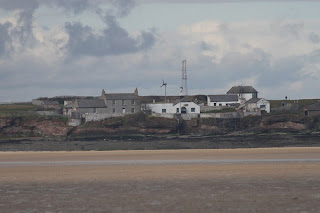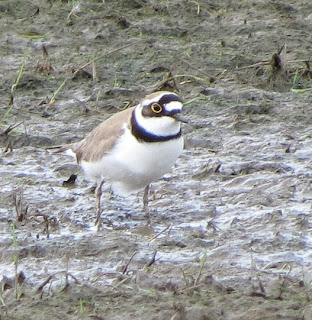 |
| On the Red Rocks, looking towards Hilbre Island - L Bimson |
Another
sunny Saturday saw an expanded Leasowe light brigade (16 of us today) rocking
at the Red Rocks, well maybe a slow fox trot, as the weather was a just a bit too chilly with the wind
blowing in off the Irish sea, it sucked away any warmth provided by the bright
sunshine. Alas it would also be
detrimental to our bird watching, as the mudflats were devoid of bird life; a few
distant birds could be seen flying about Hilbre Island.
 |
| Hilbre Island - N Prendergast |
We didn’t tarry, just
long enough for Chris to point out the buildings and the ringers heligan traps on Hilbre,
and the importance of this dropping off point for migrants and
feeding birds waiting for the tide to
turn. We took the path along the coast towards West Kirby, checking the scrub, marsh and reed beds, backed by the Royal golf course.
Despite
the recent weather being poor and spring slow to burst the buds. Our migrants
were back, chiff chaff and whitethroat sang. Swallows skimmed the marsh, swooping
over the head of a single Wheatear braving the blow. An elusive sedge warbler
was in fine voice in the reed bed but despite straining every eyeball, he
evaded our gaze. More familiar birds were about, always a joy to behold a skylark high in the sky, fluttering then parachuting
down, all the time singing his territorial warbling song. Another melodious
attractive finch is the linnet, another opportunity for Chris to point out identifying
marking on its chest and tail. (Skylarks and Linnets are both on the conservation
red list along with our House Sparrows)
 |
| Reed bed & Dunes - L Bimson |
Other
more common a garden birds, wrens, house sparrows, goldfinches and blackbirds,
flitted between the neighbouring gardens and the gorse/ shrubs.
Our only birds
of prey for the day were a buzzard and later a sparrowhawk smoothly gliding through
from the gardens and out over the golf course.
The reed beds
only other obvious occupants were reed buntings, a few snoozing Mallards and a
hidden Moorhen prrp!
Exploring
the nearby natterjack slacks, we came across some tadpoles but these would be
the offspring of frogs, the natterjack breeding a little later in the year.
Looking
out over the shore from the sand dunes, 2 shelduck were accompanied by a party
of 4 white wagtails, a little further
out a mixed flock of dunlin and ringed plover busily probed the mud. Gregarious,
skittish, and fast of foot, a pleasure to watch, suddenly taking flight on mass spooked by an
unseen foe, twisting and turning in unison until landing on the sandstone safety of little eye.
 |
| Busy...Ringed Plover & Dunlin - L Bimson |
Returning
to the rocks, waiting for the tide to race in, we took timeout to admire
various early flowers, garden escapees or deliberately scattered? Narcissi and grape hyacinths, free seeding
Honesty and cranesbills. Nettles flourished along the path, Chris determined to
show us white/red dead nettles don’t sting!
Pretty clumps of White Sea scurvy shone out,
one of the first plants to flower on the marsh. The only butterflies to brave
the blow were small tortoiseshells, seen sunning themselves in sheltered areas.
 |
| Sea scurvy - L Bimson |
 |
| Tortoiseshell - N Prendergast |
We hoped
the distant waders on the shoreline near Hoylake life boat station would be flushed
our way by the incoming tide, however once again the wind was against us and
the only birds to come our way was a solitary cormorant, a group of 4 curlews and a large party of mixed gulls. The only bird of note, a distant
Gannet further out on the horizon, past the wind turbines, travelling out to
sea.
Time for
home. Not a great haul for the day, only
28 species seen, but another informative amble in the fresh sea air and a home
baked lemon curd cake from Tomo to finish the day - Yummy.
Bimo
Our Red Rocks
Day list: 28 species
Shelduck, mallard, buzzard, ringed plover, dunlin, cormorant,
curlew, gannet, black headed gull, lesser black backed gull , herring gull,
wood pigeon, skylark, swallow, meadow
pipit, white wagtail, wren, wheatear, blackbird, house sparrow, whitethroat,
chiff chaff, magpie, carrion crow,
chaffinch, goldfinch, linnet, reed bunting.













